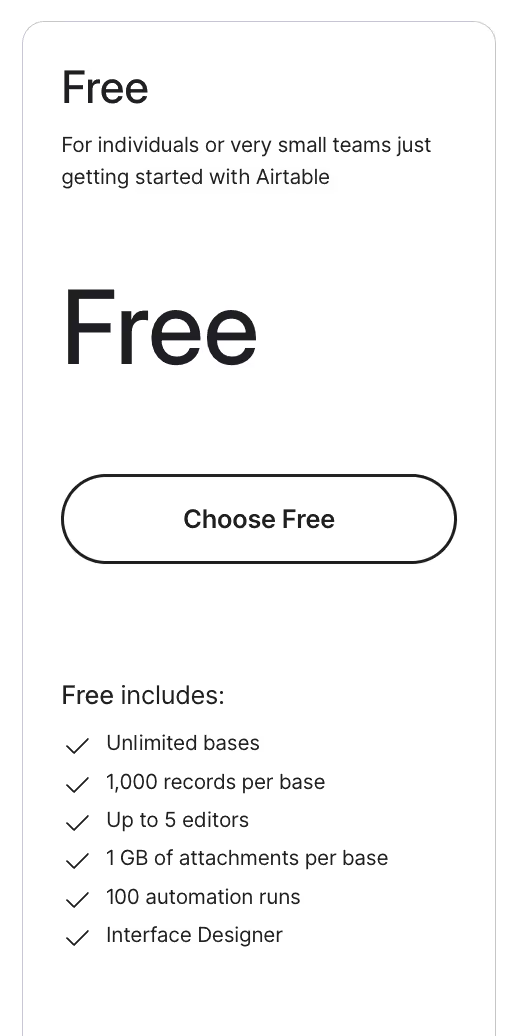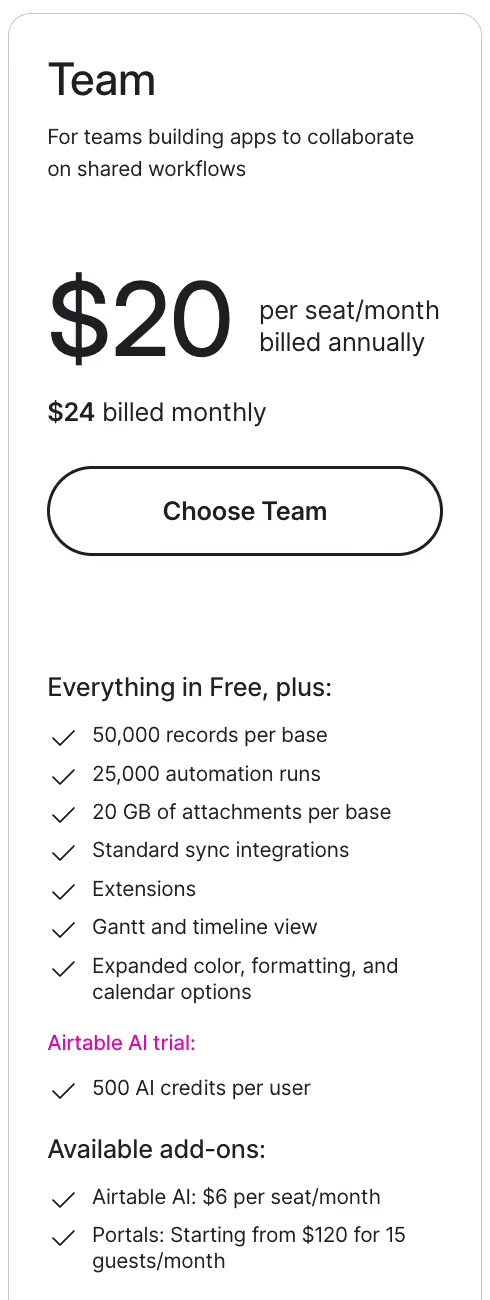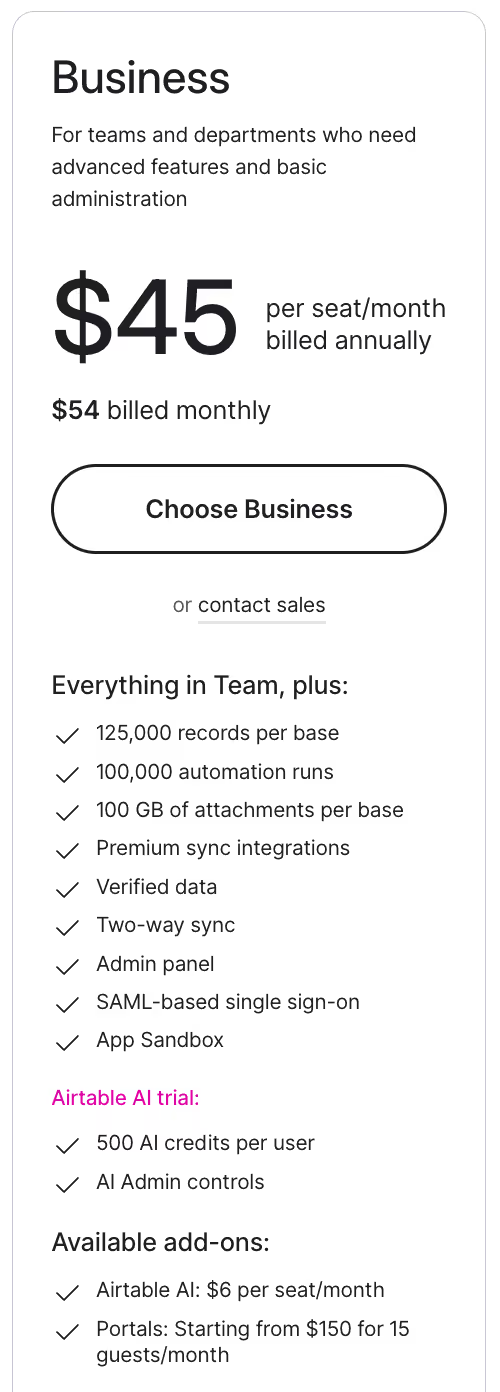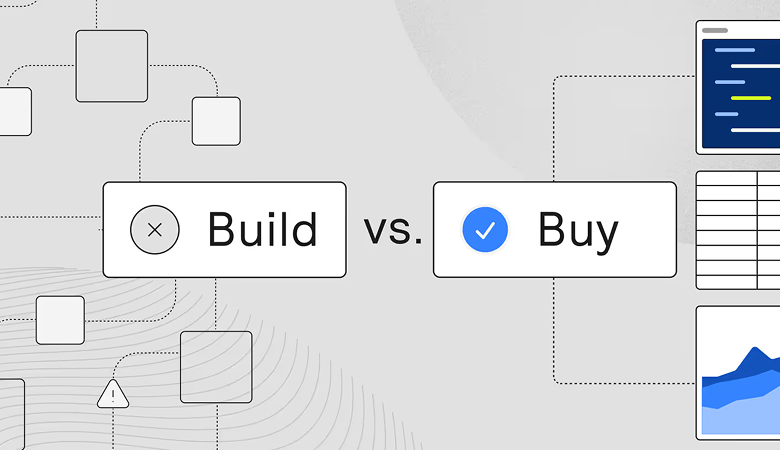Airtable is a no-code platform that combines the structure of a database with the ease of a spreadsheet. It lets teams build custom tools to manage tasks, projects, content, and operations without writing code.
As of 2025, Airtable has a free plan for up to 5 editors and team plans starting at $20 to $24 per seat monthly. In Airtable’s pricing, you pay a flat rate per editor “seat,” but each tier also comes with usage caps (on records, storage, automations, etc.) rather than pure pay-as-you-go pricing.
Note: For the most up-to-date fees, check Airtable’s pricing page. Plan details may change over time.
What are the Airtable pricing plans?
The Airtable pricing model sets limits on records, storage, and automation runs through several plans. Below is a closer look at each option.
Airtable Free plan

Airtable Free plan includes 1,000 records per base, 1 GB of attachments, 100 automation runs, and up to 5 editors.
The Airtable free plan gives new users access to basic features and is a good entry point to try the platform.
What’s included:
- Unlimited bases with up to 1,000 records each
- Basic views and Interface Designer
- 1 GB of file attachments per base
- 100 automation runs per month
- Up to 5 editors per workspace
- Two-week revision history
- API access (1,000 calls/month)
Airtable Team plan

Airtable Team plan costs $20 per seat/month annually and adds 50,000 records, 25,000 automations, sync integrations, Gantt view, and extensions.
The Airtable price increases here, but so do the features. Here’s what’s included:
- 50,000 records/base
- 20 GB attachments
- 25,000 automation runs/month
- 1-year revision history
- Gantt, Timeline, and Calendar views
- Unlimited extensions and Interface Designer
- Standard sync integrations (single-source only)
- Locked views and field permissions
- 100,000 API calls/month
Airtable Business plan

Airtable Business plan costs $45 per seat/month annually and includes 125,000 records, 100,000 automations, two-way sync, admin panel, and SAML SSO.
The Airtable Business plan features more controls, better data syncing, and larger limits.
What’s included:
- 125,000 records/base
- 100 GB attachments
- 100,000 automation runs/month
- 1 year of revision and snapshot history
- Premium integrations, including Salesforce and Jira
- Two-way and multi-source sync
- Verified data (define trusted tables for org-wide use)
- Admin Panel for workspace management
- SAML Single Sign-On (SSO)
- Unlimited API calls
Airtable Enterprise Scale plan

Airtable Enterprise Scale plan offers 500,000+ records, 1 TB of attachments, HyperDB, Enterprise Hub, audit logs, and on-site sync integration.
Airtable enterprise pricing offers extra security, support, and greater scalability requirements.
What’s included:
- 500,000+ records per base (with HyperDB, it can go into the millions)
- 1 TB of attachment storage per base
- 500,000 automation runs/month
- Enterprise Hub (org-wide admin visibility)
- Enterprise API and audit logging
- On-premises sync integrations
- Data loss prevention tools
- Granular user roles
- Custom onboarding and a dedicated success manager
Remember: Pricing, plans, and features can change. For the most current details, refer to Airtable’s pricing page. For background on usage-based pricing for SaaS, read our guide.
Airtable AI pricing
All plans include AI credits as part of the monthly usage allowances. The monthly AI credits included per plan are:
- Free: 500 credits per editor
- Team: 15,000 credits per billable collaborator
- Business: 20,000 credits per paid user
- Enterprise Scale: 25,000 credits per paid user
Airtable AI availability
AI is available on all plans (including Free). Credit allowances reset monthly (or at the billing cycle for self‑serve plans), and additional credit packs are available on paid tiers.
Airtable nonprofit pricing
Airtable offers discounts for qualifying nonprofit organizations. Here are three key aspects to keep in mind:
- 50% off the Team plan for qualifying nonprofits
- Must apply through Airtable’s nonprofit program
- Requires nonprofit verification and approval
Key elements of Airtable’s pricing approach
Airtable’s pricing is based on per-user rates, but usage limits play a major role in your total cost. Each plan includes caps on records per base, attachment storage, automation runs, and API calls. These usage thresholds affect when and why teams need to upgrade:
- Per-seat billing with usage limits: Pricing is per editor seat and tied to usage limits for records, storage, automation runs, and API calls. Hitting a limit pauses that action until users reduce usage or move to a plan with higher thresholds.
- Airtable Portals pricing: Portals let users share data externally with fine-grained permissions. Airtable Portals is a paid add‑on. Team starts at $120/month for 15 portal seats; Business starts at $150/month for 15 seats. Enterprise-scale pricing is custom.
- Airtable nonprofit pricing: Qualifying organizations can apply for Airtable nonprofit pricing, which offers discounts on paid plans. Eligibility requires program approval.
Note: If you’re exploring different pricing models for products or experimenting with new tiers, our pricing experiments article can help.
Why do companies like Airtable adopt usage-based billing?
Companies adopt usage-based components when value and cost vary with activity. In Airtable’s case, limits on records, storage, and automations help align plan tiers with product use.
For customers, this pairing offers clarity: seat count covers collaboration, while usage tiers reflect the scope of work. As needs grow, teams move to plans with higher limits and admin features rather than incurring overages.
Note: Building AI agents with usage-based pricing in mind? Grab our eBook on pricing AI agents and check the how-to guide for implementing agent pricing in Orb.
Why is usage-based billing becoming the default?
Many teams prefer pricing that scales with how they actually use a platform. A hybrid of per-seat access plus usage thresholds for records, storage, and automations maps cost to activity, and supports variable workloads. Here’s why usage-based billing is becoming the norm.
Aligns price with value
When usage grows (more records, heavier automations, higher API activity), spend rises in step. Lighter teams pay for lower limits, while data-heavy operations pay for higher thresholds and governance features. This approach keeps the relationship between consumption and cost clear.
Supports variable workloads
Projects spike during launches, audits, or seasonal cycles. Usage-based elements absorb those peaks without forcing a permanent jump to an oversized plan. Teams scale up their limits when needed, then normalize when activity settles.
Enables safe pricing experiments
Product teams can test new metrics and thresholds, observe adoption, and adjust. Changes roll out as updated limits or add-ons instead of rare, disruptive pricing resets.
That makes it easier to introduce features like AI credits or external-sharing capacity (e.g., portals) with clear consumption rules.
Works for diverse customer profiles
Smaller teams start with modest limits and simple admin. Larger organizations adopt higher tiers for security, identity, audit, and throughput. The same structure serves both, with room to grow via limits and add-ons.
Note: For deeper context, see our other posts about usage-based pricing for SaaS and pricing models for products.
FAQs
Is Airtable free?
Yes, Airtable offers a free plan with no time limit, which includes up to 1,000 records per base, 1 GB of storage, and limited automation runs. It allows people to test out the platform. Teams needing more capacity or advanced features should upgrade.
How much is Airtable per month?
Airtable’s paid plans start at $20 per user/month (billed annually) for the Team plan and $45 per user/month for the Business plan. Monthly billing costs $24 and $54 per user/month, respectively. Enterprise pricing is custom and based on usage and support needs.
What is Airtable used for?
Airtable is used to build custom workflow tools for teams of all sizes. People use it for project tracking, CRM systems, editorial calendars, content planning, inventory tracking, and more. It’s common in marketing, product management, operations, and even finance teams.
How does Airtable enterprise pricing work?
Enterprise Scale is custom-priced and includes organization-wide admin, advanced security, and higher capacity. You’ll have to contact Airtable’s sales team for a quote.
What are Airtable Business plan features?
Business increases record, storage, and automation limits, and adds two-way sync, admin controls, and identity options like SAML SSO.
How does Airtable AI pricing work?
Airtable AI credits are now part of all their pricing plans. Customers on paid plans can also purchase additional AI credit packs if they exhaust their monthly quota.
How do I downgrade collaborators on Airtable?
To lower your Airtable cost, you can downgrade paid collaborators. On Team, commenters are billable; only read‑only collaborators are free. On Business, commenters are not billed (only editors and above are billable).
How much does it cost to get an Airtable certification?
Airtable offers certification through Airtable Academy. Its e‑learning and certifications are free for all users. The Academy includes study materials and one attempt at the test. Certification is optional but can be valuable for users building workflows or training others.
Learn how Orb supports usage-based billing
With Orb, teams define clear pricing rules, unlock their usage data, and generate auditable invoices. Monetization keeps pace with product changes, since pricing and billing changes don’t require engineering, and teams can ditch fragile spreadsheets.
Whether you're offering tiered plans, usage caps, or a hybrid model, Orb is the billing platform that equips you to design and operate pricing systems that evolve with your product.
Here’s how Orb supports seat-plus-usage pricing models:
- Meter usage precisely across your product: Orb ingests raw event data. We ensure accurate and transparent invoices for your customers, even as you change your pricing.
- Design and test pricing rules without writing code: Define billing metrics using the Orb SQL Editor or a visual editor and build new pricing plans. Set metered dimensions, thresholds, tiers, and credits in one place.
- Version and roll out new plans safely: Launch pricing experiments, adjust entitlements, and iterate on models with built-in controls. Even as you evolve your pricing, invoices are automatically recalculated in order to remain accurate.
- Forecast pricing changes with real usage data: Run Orb Simulations on historical data to preview revenue and usage outcomes before launch. Orb enables forecasting so that the finance and product teams make more informed decisions.
- Send transparent, usage-based invoices to customers: Orb reduces billing errors by turning raw usage data into fully auditable invoices. By performing calculations based on raw data, Orb helps make sure that your pricing updates are reflected in user bills.
- Integrate billing into your financial systems with confidence: Orb connects to your accounting and data stack, syncing billing, invoicing, and reporting so operations scale as usage grows.
Seat-plus-usage pricing offers a combination of predictable and scalable revenue, provided the right systems are in place. Orb gives you the infrastructure to launch and evolve usage-based or tiered pricing accurately and fast.
If you want to launch seat-plus-usage pricing models without complex engineering, Orb helps you do it. Explore Orb’s flexible pricing tiers and build the billing foundation your product deserves.

.avif)

